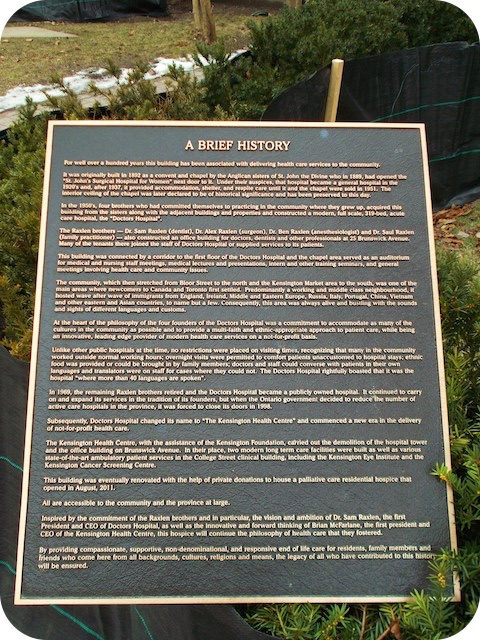Discover Toronto's history as told through its plaques
2004 - Now in our 14th Year - 2018
To see what's new on this site, you can visit the Home Page
Looking at this page on a smartphone?
For best viewing, hold your phone in Landscape mode (Horizontal)
A Brief History

Photos and transcription by contributor Wayne Adam - Posted April 2017


This plaque, a brief history of Kensington Hospice, can be found in front of 38 Major Street, north of College Street. Here's what it says:
Coordinates: 43.659159 -79.403537 |
 |
For well over a hundred years this building has been associated with delivering health care services to the community.
It was originally built in 1892 as a convent and chapel by the Anglican sisters of St. John the Divine who in 1889, had opened the "St. John's Surgical Hospital for Women" next door to it. Under their auspices, that hospital became a general hospital in the 1920's and, after 1937, it provided accommodation, shelter, and respite care until it and the chapel were sold in 1951. The interior ceiling of the chapel was later declared to be of historical significance and has been preserved to this day.
In the 1950's, four brothers who had committed themselves to practicing in the community where they grew up, acquired this building from the sisters along with the adjacent buildings and properties and constructed a modern, full scale, 319-bed acute care hospital, the "Doctors Hospital".
The Raxien brothers -- Dr. Sam Raxien (dentist), Dr. Alex Raxien (surgeon), Dr. Ben Raxien (anesthesiologist) and Dr. Saul Raxien (family practitioner) -- also constructed an office building for doctors, dentists and other professionals at 25 Brunswick Avenue. Many of the tenants there joined the staff of Doctors Hospital or supplied services to its patients.
This building was connected by a corridor to the first floor of the Doctors Hospital and the chapel area served as an auditorium for medical and nursing staff meetings, medical lectures and presentations, intern and other training seminars, and general meetings involving health care and community issues.
The community, which then stretched from Bloor Street to the north and the Kensington Market area to the south, was one of the main areas where newcomers to Canada and Toronto first settled. Predominantly a working and middle class neighbourhood, it hosted wave after wave of immigrants from England, Ireland, Middle and Eastern Europe, Russia, Italy, Portugal, China, Vietnam and other eastern and Asian countries, to name but a few. Consequently, this area was always alive and bustling with the sounds and sights of different languages and customs.
At the heart of the philosophy of the four founders of the Doctors Hospital was a commitment to accommodate as many of the cultures in the community as possible and to provide a multi-faith and ethnic-appropriate approach to patient care, while being an innovative, leading edge provider of modern health care services on a not-for-profit basis.
Unlike other public hospitals at the time, no restrictions were placed on visiting times, recognizing that many in the community worked outside normal working hours; overnight visits were permitted to comfort patients unaccustomed to hospital stays; ethnic food was provided or could be brought in by family members; doctors and staff could converse with patients in their own languages and translators were on staff for cases where they could not. The Doctors Hospital rightfully boasted that it was the hospital "where more than 40 languages are spoken".
In 1969, the remaining Raxlen brothers retired and the Doctors Hospital became a publicly owned hospital. It continued to carry on and expand its services in the tradition of its founders, but when the Ontario government decided to reduce the number of active care hospitals in the province, it was forced to close its doors in 1998.
Subsequently, Doctors Hospital changed its name to "The Kensington Health Centre" and commenced a new era in the delivery of not-for-profit health care.
The Kensington Health Centre, with the assistance of the Kensington Foundation, carried out the demolition of the hospital tower and the office building on Brunswick Avenue. In their place, two modern long term care facilities were built as well as various state-of-the-art ambulatory patient services in the College Street clinical building, including the Kensington Eye Institute and the Kensington Cancer Screening Centre.
This building was eventually renovated with the help of private donations to house a palliative care residential hospice that opened in August, 2011.
All are accessible to the community and the province at large.
Inspired by the commitment of the Raxien brothers and in particular, the vision and ambition of Dr. Sam Raxien, the first President and CEO of Doctors Hospital, as well as the innovative and forward thinking of Brian McFarlane, the first president and CEO of the Kensington Health Centre, this hospice will continue the philosophy of health care that they fostered.
By providing compassionate, supportive, non-denominational, and responsive end of life care for residents, family members and friends who come here from all backgrounds, cultures, religions and means, the legacy of all who have contributed to this history will be ensured.
Related webpages
Kensington Hospice
Sisterhood of St. John the Divine
More
Medical Buildings
Here are the visitors' comments for this page.
(none yet)
Here's where you can send me a comment for this page.
Note: Your email address will be posted at the end of your comment so others can respond to you unless you request otherwise.
Note: Comments are moderated. Yours will appear on this page within 24 hours (usually much sooner).
Note: As soon as I have posted your comment, a reply to your email will be sent informing you.
To send me your comment, click [email protected].
Thanks
Webmaster
Note: If you wish to send me a personal email, click here.